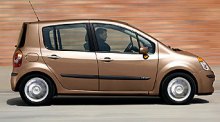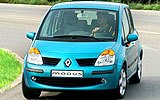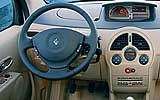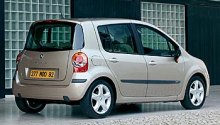|
 The
original product lineup of Renault consists of Twingo, Clio, Megane,
Laguna
and Vel Satis. That's a logical series, ranging from small to big,
cheap
to expensive, spanning neatly across every segment. But since the late
90s the automotive market has become more and more deviated. Many
cross-segment
cars emerged into the market. Today, we have crossover vehicles like
Renault
Scenic (between family hatch and MPV), Volvo XC90 (between SUV and
MPV),
Seat Altea (between MAV and hot hatch), Chrysler Pacifica (between
station
wagon and SUV), Opel Meriva (between supermini and MAV) and undoubtedly
more and more to come. The
original product lineup of Renault consists of Twingo, Clio, Megane,
Laguna
and Vel Satis. That's a logical series, ranging from small to big,
cheap
to expensive, spanning neatly across every segment. But since the late
90s the automotive market has become more and more deviated. Many
cross-segment
cars emerged into the market. Today, we have crossover vehicles like
Renault
Scenic (between family hatch and MPV), Volvo XC90 (between SUV and
MPV),
Seat Altea (between MAV and hot hatch), Chrysler Pacifica (between
station
wagon and SUV), Opel Meriva (between supermini and MAV) and undoubtedly
more and more to come.
Like
Opel Meriva, Fiat Idea and Toyota Yaris Verso, Renault Modus is a
crossover
between supermini and MAV. It just biases more towards supermini. Based
on the next generation Clio platform, the Modus is seen as an
attractive
alternative to your regular supermini. Some people even predict in the
future all superminis will look like that. It will undoubtedly steal a
lot of sales from Clio, but it will also widen the customer base for
Renault.
If everything go as planned, it will generate 300,000 units of sales
every
year !
 The
Modus looks pretty and cheerful, with a smiling face and a pair of big
eyes. Huge windows in combination with low waistline not only look
smart
but also brighten the cabin. Its build quality exceeds that of the
supermini
standard, more in line with Megane and Scenic. Soft-touch plastics and
high level of fit and finish deliver a premium feel, a big contrast to
the raw Meriva. Colorful seats and 2-tone color scheme on the dashboard
lifts the ambience. The
Modus looks pretty and cheerful, with a smiling face and a pair of big
eyes. Huge windows in combination with low waistline not only look
smart
but also brighten the cabin. Its build quality exceeds that of the
supermini
standard, more in line with Megane and Scenic. Soft-touch plastics and
high level of fit and finish deliver a premium feel, a big contrast to
the raw Meriva. Colorful seats and 2-tone color scheme on the dashboard
lifts the ambience.
The
car occupies the same road space as Clio, but its 1.59m height exceeds
Clio by a massive 17cm. This give it enormous headroom. As for legroom,
the 2482mm wheelbase is no match for Meriva's 2630mm, but Modus follows
its rival to use a sliding rear seat to enable flexible distribution of
passenger and luggage room. In the forward position, the rear bench can
sit 3 people tightly but offer more luggage space. If you flip the
center
cushion and push the outer seats inward, you can slide the rear bench
backward,
creating an additional 17cm legroom ! in this case the Modus becomes a
roomy 4-seater.
 Underpinning
the Modus is the first common platform between Renault and Nissan. It
has
been used in Nissan March (Micra) and will be shared with the
forthcoming
Clio III, Twingo II and Nissan Tone to optimize savings. As a tradition
of Renault, the platform is unsophisticated, employing the popular
strut
and torsion-beam suspensions and electric power steering to keep cost
down.
That's why Renault can offer a high quality package at a reasonable
price. Underpinning
the Modus is the first common platform between Renault and Nissan. It
has
been used in Nissan March (Micra) and will be shared with the
forthcoming
Clio III, Twingo II and Nissan Tone to optimize savings. As a tradition
of Renault, the platform is unsophisticated, employing the popular
strut
and torsion-beam suspensions and electric power steering to keep cost
down.
That's why Renault can offer a high quality package at a reasonable
price.
The
engine range consists of an entry-level 75hp 1.2-litre 16V, a 98hp
1.4-litre
16V, a 113hp 1.6-litre 16V with variable valve timing and a couple of
1.5dCi
common-rail injection turbo diesel engines. Different state of tune
result
in either 65hp or 82hp. Because the Modus has a weight penalty of 100kg
over Clio, you had better to choose the most powerful engines. The 1.6
petrol is always an eager engine, but the 82hp 1.5dCi actually suits
the
Modus better. Its 12.5 sec 0-60 may seems slow, but the strong
mid-range
torque (up to 136 lbft) is useful in real world driving, while its
smoothness
and quietness are always highly praised by road testers, let alone the
fuel economy it brings. Most important, the diesel engine's relaxed
manner
suits the character of Modus. This is a comfort-oriented car.
 There
is no point to attack corners as in a hot hatch. However, if you do so,
you will find the Modus resists body roll surprisingly well for a car
so
tall, thanks to the stiffer suspension setup. The down side is a ride
harsher
than what you would expect for a French car, though it beats Honda
Jazz.
Predictably, the electric power steering lacks feel, but that matters
little
to those buying this kind of cars. There
is no point to attack corners as in a hot hatch. However, if you do so,
you will find the Modus resists body roll surprisingly well for a car
so
tall, thanks to the stiffer suspension setup. The down side is a ride
harsher
than what you would expect for a French car, though it beats Honda
Jazz.
Predictably, the electric power steering lacks feel, but that matters
little
to those buying this kind of cars.
Will
the likes of Modus supersede superminis in the future? I hope not.
Admittedly,
its added space and versatility is very attractive to most people, but
it won't bring as much driving fun as a normal hatchback. As long as
car
enthusiasts not die out, car makers should continue making regular
hatchbacks. |